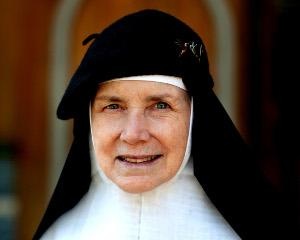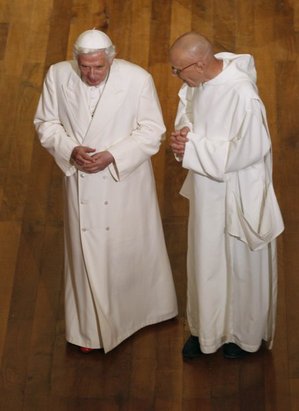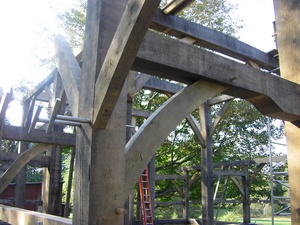 You can get a quick visit to Saint Meinrad’s Archabbey in 2 minutes via YouTube. David Yonke put together a very nice video with good images and music. Brother Francis de Sales Wagner posted the video on his delightful blog, The Path of Life.
You can get a quick visit to Saint Meinrad’s Archabbey in 2 minutes via YouTube. David Yonke put together a very nice video with good images and music. Brother Francis de Sales Wagner posted the video on his delightful blog, The Path of Life.
Tag: monastery
Saint Anthony Anthony of the Desert
Saint Anthony, father of Monks, intercede for the monastic life in the present day for the monks and nuns can live his consecration in awe and charity at all pleasing only to God.
Saint Anthony Anthony of the Desert (c. 251-356) was a friend of God, and therefore a son and brother to others. His friendship with God flowed from his obedience (his listening to and building his relationship).
He’s known as the founder of monasticism. His rule of life established guidelines for living together as Christians. This is what came to be known as “monastic,” the intense and purpose driven living of the Gospel. Following the death of his parents and providing for his younger sister, Anthony became a monk at 20; his method was to live in total solitude on a desert mountain near the Nile River and eating only bread and water, which he never tasted before sunset, and sometimes only once in two, three, or four days. In the spiritual life the desert is the place to do battle with sin. Anthony shows us that it possible to overcome the temptations of the devil; emerging about 20 years later from total seclusion to instruct hermits in the ways of the Gospel, monasticism, Anthony gave witness to the power of Jesus Christ in his capacity to the heal the sick, being a spiritual father, by casting out demons and preaching. From him we begin to realize that not everything lasts forever. It is said that he lived at least to 100 years.
It is Saint Athanasius’s Life of Saint Anthony that perpetuates the narrative and inspired waves of monks who civilized and evangelized Europe and the Near East. Anthony established a monastery between the Nile and the Red Sea, which exists today.
Saint Anthony, pray for us. Help is to renew and in some cases, refound the monastic living.
Remembering Cyril
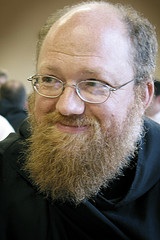 My friend Father Cyril Crawford died unexpectedly a short time ago, on 15 May 2012. He died in his sleep in Leuven (Louvain), Belgium, at the Katholieke Universiteit Leuven, where he was working on a doctorate in Philosophy so that he could teach at his monastery’s college.
My friend Father Cyril Crawford died unexpectedly a short time ago, on 15 May 2012. He died in his sleep in Leuven (Louvain), Belgium, at the Katholieke Universiteit Leuven, where he was working on a doctorate in Philosophy so that he could teach at his monastery’s college.
Dolores Hart steps out of the Abbey to help her sisters
Continue reading Dolores Hart steps out of the Abbey to help her sisters
Pope Benedict throws light on the value of the monastic life
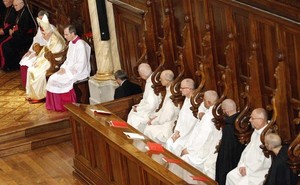 In speaking at a Charterhouse on October 9, Pope
In speaking at a Charterhouse on October 9, Pope
Benedict contrasted modern life and the monastic life saying that society
“throws light on the specific charism of the Carthusian monastery as a
precious gift for the Church and for the world, a gift which contains a
profound message for our lives and for all humanity. I would summarise it in
these terms: by withdrawing in silence and solitude man, so to speak, ‘exposes’
himself to the truth of his nakedness, he exposes himself to that apparent
‘void’ I mentioned earlier. But in doing so he experiences fullness, the
presence of God, of the most real Reality that exists. … Monks, by leaving
everything, … expose themselves to solitude and silence so as to live only
from what is essential; and precisely in living from the essential they
discover a profound communion with their brothers and sisters, with all
mankind”.
journey, a lifelong search. … Becoming a monk requires time, exercise,
patience. … The beauty of each vocation in the Church lies in giving time to
God to work with His Spirit, and in giving time to one’s own humanity to form,
to grow in a particular state of life according to the measure of maturity in
Christ. In Christ there is everything, fullness. However we need time to
possess one of the dimensions of His mystery. … At times, in the eyes of the
world, it seems impossible that someone should spend his entire life in a
monastery, but in reality a lifetime is hardly sufficient to enter into this
union with God, into the essential and profound Reality which is Jesus
Christ”.
Holy Father told the monks at the end of his homily. “You, who live in
voluntary isolation, are in fact at the heart of the Church; you ensure that
the pure blood of contemplation and of God’s love flows in her veins”.
Tithing barn building at a CT monastery
Monks from St Bernard’s Abbey on EWTN’s Life on the Rock
Silence is the environmental condition to listen to God

Image via Wikipedia
Continue reading Silence is the environmental condition to listen to God
Monasteries are true and proper oases for humanity, Benedict XVI reminds us
In Wednesday’s edition of L’Osservatore Romano, Pope Benedict told the listeners of the Wednesday General Audience that the monastic life is an essential value for humanity and for the Church, today. The Pope’s emphasis on beauty and silence helps us to appreciate and to listen God’s promptings of the desires of the heart is important. Let’s pay attention to what the Pope has to say. You may also want to watch the Rome Reports news video.
The editor writes, “Monasteries are true and proper oases of the spirit in which God speaks to humanity. The Pope said this to faithful at the General Audience of Wednesday, 10 August, that was held in the courtyard of the Papal Residence at Castel Gandolfo.”
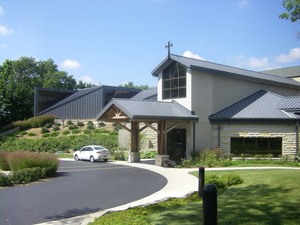 Dear Brothers and Sisters! In every age, men and women who have consecrated their lives to God in prayer – like monks and nuns – have established their communities in particularly beautiful places: in the countryside, on hilltops, in valleys, on the shores of lakes or the sea, or even on little islands. These places unite two elements which are very important for contemplative life: the beauty of creation, which recalls that of the Creator, and silence, which is guaranteed by living far from cities and the great means of communication. Silence is the environmental condition that most favors contemplation, listening to God and meditation. The very fact of experiencing silence and allowing ourselves to be “filled,” so to speak, with silence, disposes us to prayer. The great prophet, Elijah, on Mount Horeb – that is, Sinai – experienced strong winds, then an earthquake, and finally flashes of fire, but he did not recognize the voice of God in them; instead, he recognized it in a light breeze (cfr. 1 Rev 19:11-13). God speaks in silence, but we need to know how to listen. This is why monasteries are oases in which God speaks to humanity; and there we find the courtyard, a symbolic place because it is a closed space, but open toward the sky.
Dear Brothers and Sisters! In every age, men and women who have consecrated their lives to God in prayer – like monks and nuns – have established their communities in particularly beautiful places: in the countryside, on hilltops, in valleys, on the shores of lakes or the sea, or even on little islands. These places unite two elements which are very important for contemplative life: the beauty of creation, which recalls that of the Creator, and silence, which is guaranteed by living far from cities and the great means of communication. Silence is the environmental condition that most favors contemplation, listening to God and meditation. The very fact of experiencing silence and allowing ourselves to be “filled,” so to speak, with silence, disposes us to prayer. The great prophet, Elijah, on Mount Horeb – that is, Sinai – experienced strong winds, then an earthquake, and finally flashes of fire, but he did not recognize the voice of God in them; instead, he recognized it in a light breeze (cfr. 1 Rev 19:11-13). God speaks in silence, but we need to know how to listen. This is why monasteries are oases in which God speaks to humanity; and there we find the courtyard, a symbolic place because it is a closed space, but open toward the sky.
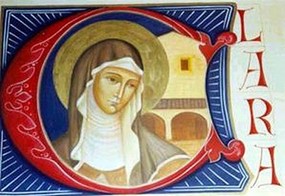 Tomorrow, dear friends, we will celebrate the memory of St. Clare of Assisi. So I would like to recall one of these “oases” of the spirit which is particularly dear to the Franciscan family and to all Christians: the little convent of San Damiano, situated just beneath the city of Assisi, among the olive groves that slope towards Santa Maria degli Angeli. In that little church, which Francis restored after his conversion, Chiara and her first companions established their community, living off prayer and little works. They were called the “Poor Sisters,” and their “form of life” was the same as the Frati Minori: “To observe the Holy Gospel of our Lord Jesus Christ” (Rule of St. Clare, I, 2), conserving the union of reciprocal charity (cfr ivi, X, 7) and observing in particular the poverty and humility of Jesus and his Most Holy Mother (cfr, ivi, XII, 13).
Tomorrow, dear friends, we will celebrate the memory of St. Clare of Assisi. So I would like to recall one of these “oases” of the spirit which is particularly dear to the Franciscan family and to all Christians: the little convent of San Damiano, situated just beneath the city of Assisi, among the olive groves that slope towards Santa Maria degli Angeli. In that little church, which Francis restored after his conversion, Chiara and her first companions established their community, living off prayer and little works. They were called the “Poor Sisters,” and their “form of life” was the same as the Frati Minori: “To observe the Holy Gospel of our Lord Jesus Christ” (Rule of St. Clare, I, 2), conserving the union of reciprocal charity (cfr ivi, X, 7) and observing in particular the poverty and humility of Jesus and his Most Holy Mother (cfr, ivi, XII, 13).
Benedict XVI at the General Audience stresses the value of monastic spirituality God speaks in silence Benedict XVI at the General Audience stresses the value of monastic spirituality God speaks in silence and beauty of the place in which the monastic community lives – simple and austere beauty – are like a reflection of the spiritual harmony which the community itself attempts to create. The world is filled with these oases of the spirit, some very ancient, particularly in Europe; others are more recent, while still others have been restored by new communities. Looking at things from a spiritual perspective, these places of the spirit are a load-bearing structure of the world! It is no accident that many people, especially in times of rest, visit these places and stop there for some days: even the soul, thanks be to God, has its needs! The Pope continues:
Let us remember, therefore, St. Clare. But let you also remember other Saints who remind us of the importance of turning our gaze to the “things of heaven,” like St. Edith Stein, Teresa Benedicta of the Cross, Carmelite, co-patron of Europe, whom we celebrated yesterday. And today, August 10, we cannot forget St. Lawrence, deacon and martyr, with a special wish for Romans who have always venerated him as one of their patrons. Finally, let us turn our gaze to the Virgin Mary, that she may teach us to love silence and prayer.

